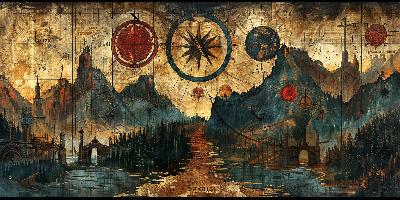Just like the Knights of Camelot embarked for a quest to find the Holy Grail, Marketing and Sales must join their forces to get leads, convert them and win opportunities.
Having a clear view of the marketing and sales funnel is crucial for reducing pain points such as inefficiencies, misalignment between teams, and lost opportunities.
While the buyer journey focuses on the external process that potential customers go through before making a purchase decision, the Marketing and Sales funnel offers an internal perspective, helping organizations manage leads through various stages. This article adopts the inner point of view for a more granular understanding and complements this article that explains the buyer journey in-depth.<<insert link here>>
We’ll use this Miro chart in this article to explain the different concepts used in marketing and sales.
Marketing ans Sales Funnel Stages and Their Relationship with TOFU, MOFU, and BOFU
Anonymous (The Initial Quest)
Phase Description: at the beginning of the quest, the knights of Camelot set off with a vague direction, not knowing who or what they will encounter. These potential leads are entirely unknown to your company. They might have seen your content or interacted with your brand, but no identifiable information is available.
Relation to TOFU: this stage corresponds to the Top of the Funnel (TOFU), where the goal is to attract as many prospects as possible.
Entry Point: prospects enter this phase through various channels such as social media posts, blog articles, videos, or online advertisements.
Exit Point: prospects move to the next phase when they take an identifiable action, such as filling out a form.
Marketing and Sales Actions:
- Marketing: focus on creating educational and engaging content that addresses common problems and introduces your brand. Use SEO, social media, and content marketing to drive traffic.
- Sales: limited involvement; the primary focus is on collecting data and insights.
Content Type
- Blog posts
- Infographics
- Educational videos
- Social media content
- Quiz
Key KPIs
- Website traffic
- Social media engagement
- Content views
Pre-MQL (The Journey Through the Enchanted Forest)
Phase Description: as the knights journey through the enchanted forest, they begin to encounter signs and clues, though the path is still unclear. In this stage, some initial interaction has occurred, but the lead is not yet qualified. They might have filled out a basic form or downloaded a piece of content.
Relation to TOFU/MOFU: this stage straddles both the Top, Middle and Bottom of the Funnel (TOFU – MOFU – BOFU). The lead begins to show more interest and engagement. You will progressively acquire more information on the lead as he will fill out progressive forms along the way; you will deduct his preferences and areas of interests from his journeys and answers.
Entry Point: prospects enter this phase by being recognized in a form or simply imported in the database, or input by a Sales person in the CRM.
Exit Point: prospects move to MQL status once they meet predefined criteria for qualification. Those criteria can often be a score level, or a more decisive action such as filling out a contact form or booking a meeting directly with a Sales person.
Marketing and Sales Actions:
- Marketing: this is the heart of the Marketing action and the sweet spot of the Marketing Automation. You need to listen to all the lead’s actions, recognize implicitly his areas of interests, propose at the right time personalized content, let him modify his preferences in the preference centre, and educate his with nurturing programs.
- Sales: again no involvement as the lead is not considered “mature” enough. We don’t want to waste time of the sales with unsuccessful discussion.
Content Types:
- Whitepapers
- Case studies
- Newsletters
Key KPIs:
- Content downloads
- Email sign-ups
- Engagement rates
MQL (The Trial by Fire)
Phase Description: reaching the trial by fire, the knights face challenges that test their readiness and commitment to the quest. A lead is classified as an MQL when they have shown significant interest and meet certain criteria indicating they are ready for a sales conversation. at this point, all the “Qualification” has been done automatically.
Relation to MOFU: this stage is at the Bottom of the Funnel (BOFU), where leads are normally fully nurtured and and ready to be qualified by a human being.
Entry Point: prospects enter this phase after engaging with content that shows a higher level of interest, such as attending a webinar or filling out a detailed contact form.
Exit Point: prospects move to the Sales Accepted Lead (SAL) phase when the sales team agrees to engage with them. this is usually done by verifying that the lead is not a duplicate from another lead already existing the database (existing prospect or customer). In the later case, the lead is pushed to the sales already taking care of the lead.
Marketing and Sales Actions:
- Marketing: continue nurturing with targeted content and automated follow-ups.
- Sales: review MQLs and prepare to reach out with personalized engagement. This is usually done by a pre-sales team (Inside Sales / Business Development Representatives) who must efficiently analyse and deduplicate the MQLs.
Content Types:
- As this phase is usually short, no content is pushed
Key KPIs:
- MQL conversion rate
- Engagement scores
- Lead quality metrics
SAL (The Council of Knights)
Phase Description: having proven their worth, the knights present themselves before the council of Camelot. In this stage, the marketing team passes the qualified lead to the sales team, which accepts it for further engagement.
Relation to MOFU/BOFU: this stage is at the Bottom of the Funnel (BOFU), as the lead is transitioning from marketing to sales.
Entry Point: prospects enter this phase after being reviewed and accepted by the sales team.
Exit Point: prospects move to the Sales Qualified Lead (SQL) phase after initial sales contact and further qualification. At this point the pre-sales team will usually want to have a conversation with the lead in order to understand the Need, the Timing, if the lead is ahs the Authority to move thing s forward, and if a Budget is already there (the BANT).
Marketing and Sales Actions:
- Marketing: support sales with relevant content and background information if needed
- Sales: begin direct engagement, understanding the lead’s needs and preparing a pitch. If succesful, the last action of the pre-sales team is to “convert” the lead into a more structured set of information in the CRM (usually Contact – Account – Opportunity) and assign a Sales on it.
Content Types:
- Sales scripts
- Personalized emails
- Meeting invitations
Key KPIs:
- Lead acceptance rate
- Time to first contact
- Engagement rates
SQL (The Knight’s Challenge)
Phase Description: now prepared for the final trials, the knights face a series of rigorous challenges. A lead becomes an SQL after the sales team has engaged and determined that they have a genuine interest and potential to convert.
Relation to BOFU: this stage is firmly at the Bottom of the Funnel (BOFU), focusing on closing the deal.
Entry Point: prospects enter this phase after a successful initial contact by the pre-sales team and needs further assessment by the sales team. The Sales team will book an appointment with the prospect and decide to move them to the next phase if they show enough interest.
Exit Point: prospects move to the Opportunity phase if they show a strong likelihood of purchasing.
Marketing and Sales Actions:
- Marketing: provide detailed product information and case studies to support the sales effort.
- Sales: conduct deep-dive conversations, address objections, and work towards conversion.
Content Types:
- Detailed product brochures
- Case studies
- ROI calculators
Key KPIs:
- SQL conversion rate
- Proposal acceptance rate
- Sales cycle length
Opportunity (The Final Trial)
Phase Description: standing on the cusp of victory, the knights face their final trial. In this stage, the lead is considered a potential customer, and efforts are focused on finalizing the deal.
Relation to BOFU: this stage is also at the Bottom of the Funnel (BOFU), emphasizing closing the deal and turning leads into customers.
Entry Point: prospects enter this phase when they are ready to make a purchasing decision. This phase is more detailed in the Sales CRMs with sub-phases which we will not detail in this article.
Exit Point: prospects move to the Won stage upon successful conversion.
Marketing and Sales Actions:
- Marketing: continue providing support with relevant content and collateral.
- Sales: negotiate terms, provide detailed proposals, and close the deal.
Content Types:
- Proposals
- Pricing guides
- Contract templates
Key KPIs:
- Opportunity win rate
- Average deal size
- Sales cycle length
Won (The Grail is Found)
Phase Description: the quest reaches its triumphant conclusion as the knights find the Holy Grail. The final stage where the lead has made a purchase, converting into a customer.
Relation to Post-Funnel: this stage goes beyond the traditional funnel into customer retention and advocacy.
Entry Point: prospects enter this phase after agreeing to purchase and completing the transaction.
Exit Point: customers ideally remain in this phase, becoming repeat buyers and brand advocates. Or we can push them into a dedicated Customer LifeCycle that will better suited to measure the Churn, the repeat purchases.
Marketing and Sales Actions:
- Marketing: engage with follow-up emails, loyalty programs, and exclusive content.
- Sales: maintain relationships, offer support, and identify opportunities for upselling or cross-selling.
Content Types:
- Follow-up emails
- Loyalty programs
- Exclusive content
- Customer surveys
Key KPIs:
- Customer retention rate
- Customer lifetime value
- Net promoter score (NPS)
Additional Steps Outside of the Marketing and Sales Funnel
While the core stages of the marketing and sales funnel are essential for managing leads, there are additional steps that need to be considered to ensure a comprehensive lead management strategy. These steps address various situations where leads may not progress through the funnel as expected and require different handling:
- Disqualified: Leads that do not fit the Ideal Customer Profile (ICP) and have no potential for business. These leads should be discarded from further campaigns to avoid wasting resources.
- Rejected by Sales: These are MQLs analyzed by the pre-sales team and found to be false “hot” leads. They are not mature enough for sales engagement and should be recycled and nurtured further.
- Recycling: This step allows resetting the behavioral scoring for leads that are lost or rejected by sales before they re-enter the funnel at the beginning. This ensures that they are properly nurtured and requalified.
- Fan: These are leads well known by the marketing or sales team who frequently engage with all marketing solicitations, potentially skewing scoring systems. Such leads should be parked in a “fan” status to manage their impact on metrics.
- Lost: Opportunities that did not convert into sales should be recycled and nurtured again after some time to attempt to win them back.
- Sleeping: Leads in the pre-MQL phase that have not shown activity for a long time. These leads need special nurturing strategies to re-engage them.
<<insert link to next article here>>
Marketing and Sales Funnel after the first purchase : Loyalty Life Cycle
For more mature enterprises, designing a “Lead Life Cycle” that unfolds after the first purchase can be beneficial. This cycle focuses on customer retention and churn prevention. It includes steps to monitor customer activity, identify at-risk customers, and implement strategies for upselling, cross-selling, and re-engaging inactive customers. This approach ensures that the relationship with the customer continues to grow and evolve, enhancing long-term loyalty and value.
The attached schema illustrates these steps and emphasizes the importance of continued engagement and personalized marketing efforts to maintain and expand customer relationships. By understanding and addressing these additional steps, businesses can create a more robust and effective lead management strategy that covers the entire customer journey.
<<insert link to deep dive into M/L funnel here>>
Conclusion
By adopting a granular view of the marketing and sales funnel, organizations can effectively manage leads through each stage, ensuring they receive the appropriate attention and resources. This approach helps in aligning marketing and sales efforts, nurturing leads efficiently, and maximizing conversion rates. Understanding each phase’s specific actions and content needs is essential for driving growth and achieving long-term success.
In your quest for the Holy Grail of customer acquisition, each stage of the funnel represents a crucial step towards achieving your ultimate goal. With the right strategies and KPIs in place, you can ensure that every lead is nurtured and guided along their journey, transforming into loyal and satisfied customers.









